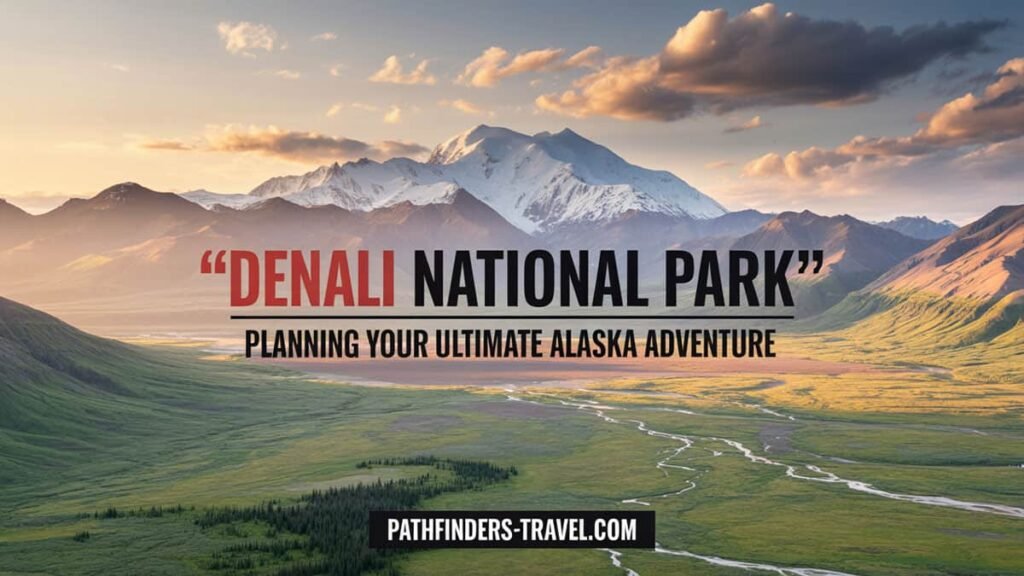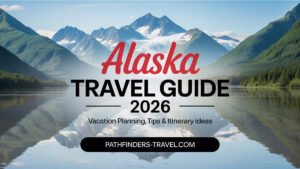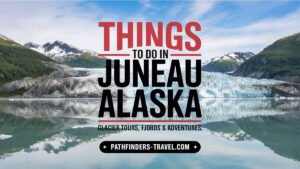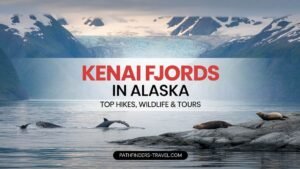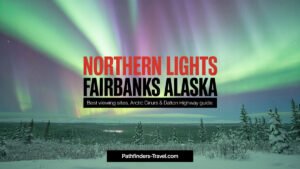Estimated reading time: 12 minutes
Last Modified Date 14/10/2025
Key Takeaways
- Denali National Park spans 6 million acres of diverse Alaskan wilderness with exceptional wildlife viewing opportunities
- The 92-mile Denali Park Road offers the best access to the park’s interior, with limited private vehicle access
- Morning and evening are prime times for spotting wildlife like grizzly bears, moose, caribou, and wolves
- Flightseeing tours from Talkeetna provide spectacular aerial views of Denali Mountain and surrounding glaciers
- The park is best visited between mid-June and early September, with July and August offering optimal weather
- Backcountry hiking requires permits and proper preparation for safety in this remote wilderness
Table of Contents
- Introduction
- Overview of Denali National Park
- Denali Park Road Tour
- Wildlife Spotting in Denali
- The Best Way to See Denali Mountain
- Denali Flightseeing Tours from Talkeetna
- Backcountry Hiking in Denali
- Practical Planning Tips
- Frequently Asked Questions about Denali National Park
- Conclusion
Introduction
Planning a trip to Denali National Park promises an adventure into one of North America’s most magnificent wilderness areas. Standing as a symbol of Alaska’s untamed beauty, this vast protected land showcases the grandeur of Denali (formerly Mount McKinley), the highest peak in North America at an impressive 20,320 feet. The park serves as a sanctuary for countless wildlife species and offers visitors a chance to experience genuine Alaskan wilderness on a grand scale. From its sweeping valleys and braided rivers to its alpine tundra and snow-capped peaks, Denali invites travelers to discover natural wonders that few other places on earth can match.
Want to explore more of Alaska’s beauty? Visit the Pathfinders Travel YouTube channel to watch our full “Wonders of Alaska” documentary in stunning 4K UHD resolution.
Overview of Denali National Park and Alaska Range Wilderness
Denali National Park encompasses over 6 million acres of protected wilderness, making it one of the largest national parks in the United States. This vast landscape showcases an incredible variety of terrains that range from low-elevation taiga forests to high alpine tundra and massive glaciers. The park sits in the heart of the Alaska Range, with the towering presence of Denali itself dominating the horizon on clear days. Alaska’s natural treasures are beautifully represented in this park’s diverse ecosystems.
The park’s varied landscapes support distinct ecological zones:
- Taiga forests cover the lower elevations, with spruce, aspen, and birch trees creating a dense woodland habitat
- Alpine tundra stretches across the mid-elevations, featuring hardy plants like dwarf shrubs, moss, and colorful wildflowers during summer
- Glacial zones occupy the highest regions, where permanent ice and snow create a stark, dramatic environment
This diversity supports an incredible range of recreational activities, making the park a destination for hikers, wildlife enthusiasts, photographers, and adventure seekers. The changing seasons transform the park dramatically, from the vibrant colors of summer tundra to the stark beauty of winter snowscapes. [SOURCE]
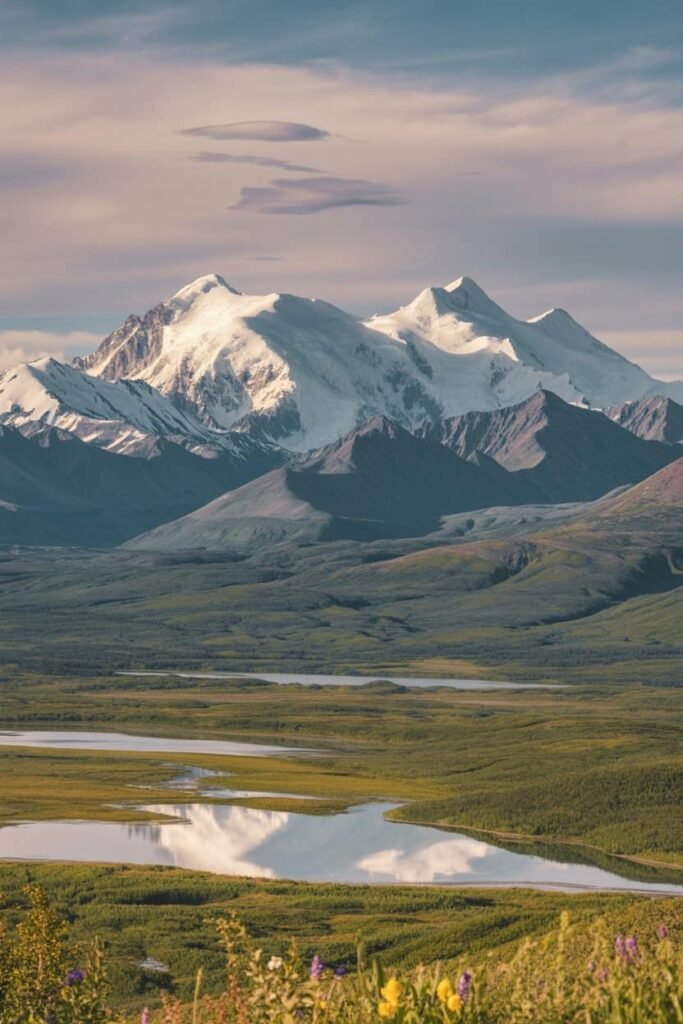
Denali Park Road Tour and Scenic Drive Itinerary
The Denali Park Road serves as the primary route into the heart of the park, stretching 92 miles from the entrance to its terminus at Kantishna. This single road provides access to some of the most spectacular scenery and wildlife viewing opportunities in North America. Understanding how this road works is crucial when planning a trip to Denali National Park.
Most visitors are surprised to learn that private vehicle access is limited to just the first 15 miles of the road (to Savage River). Beyond this point, the park maintains a bus system that helps preserve the wilderness experience and minimize wildlife disturbance. [SOURCE]
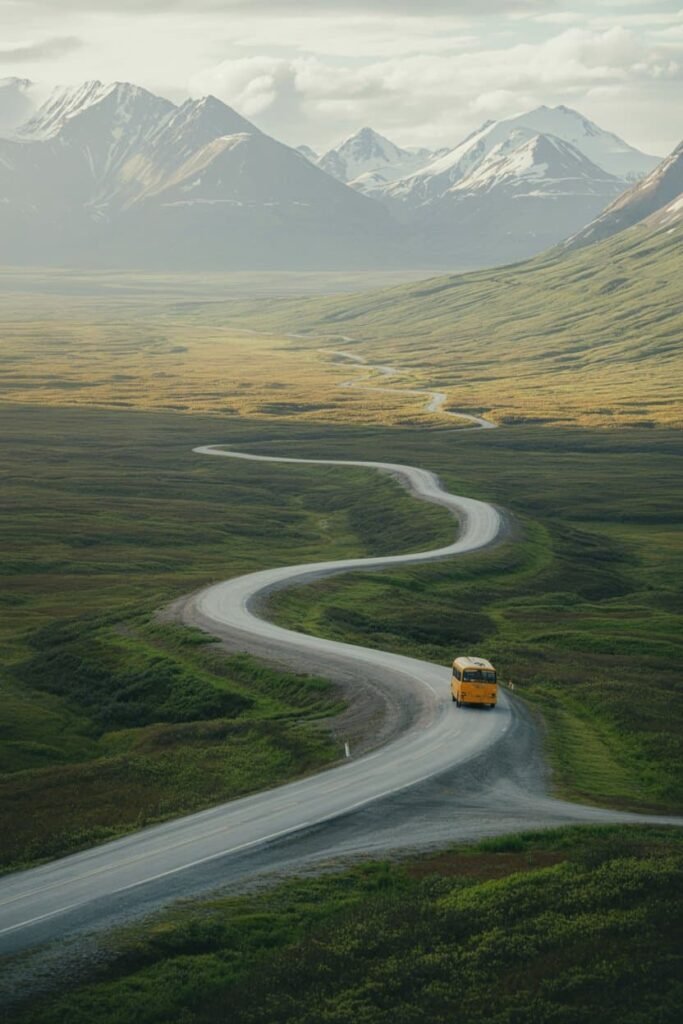
Visitors can choose between two main bus options:
- Transit buses – Non-narrated, less expensive, and allow you to get on and off along the way for hiking
- Tour buses – Narrated by trained guides, include snacks, and make scheduled stops at scenic viewpoints
The Denali Park Road Tour reveals stunning landmarks and viewpoints. Some of the most notable stops include:
- Polychrome Pass (mile 46) – Offers dramatic views of colorful mountains and the Alaska Range
- Toklat River (mile 53) – A rest stop with beautiful river valley views and often wildlife sightings
- Eielson Visitor Center (mile 66) – Provides spectacular views of Denali on clear days
- Wonder Lake (mile 85) – Famous for reflection views of Denali in calm weather
For those hoping to maximize wildlife sightings along the road, the optimal times are early morning (6-9 AM) or evening (after 6 PM) when animals are most active. Bring binoculars to spot distant wildlife and dress in layers as weather conditions can change rapidly even in summer.
Wildlife Spotting in Denali National Park and Viewing Tips
Wildlife spotting in Denali ranks among the most rewarding experiences the park offers. Unlike many other national parks, Denali provides visitors with opportunities to observe large mammals in their natural, undisturbed habitat across vast open landscapes. The park is home to what locals call the “Big Five” – grizzly bears, moose, caribou, wolves, and Dall sheep.
Each species tends to favor particular habitats within the park:
- Grizzly bears – Often spotted on open tundra slopes foraging for berries or digging for roots
- Moose – Typically found in willow thickets near water sources
- Caribou – Roam the open tundra in small groups or large herds
- Wolves – More elusive, but occasionally seen crossing valleys or ridges
- Dall sheep – Cling to steep, rocky slopes and mountain ridges
The park also supports a rich diversity of smaller mammals including red foxes, lynx, marmots, and arctic ground squirrels. Bird watchers will appreciate golden eagles, gyrfalcons, ptarmigan, and many migratory species during summer months.
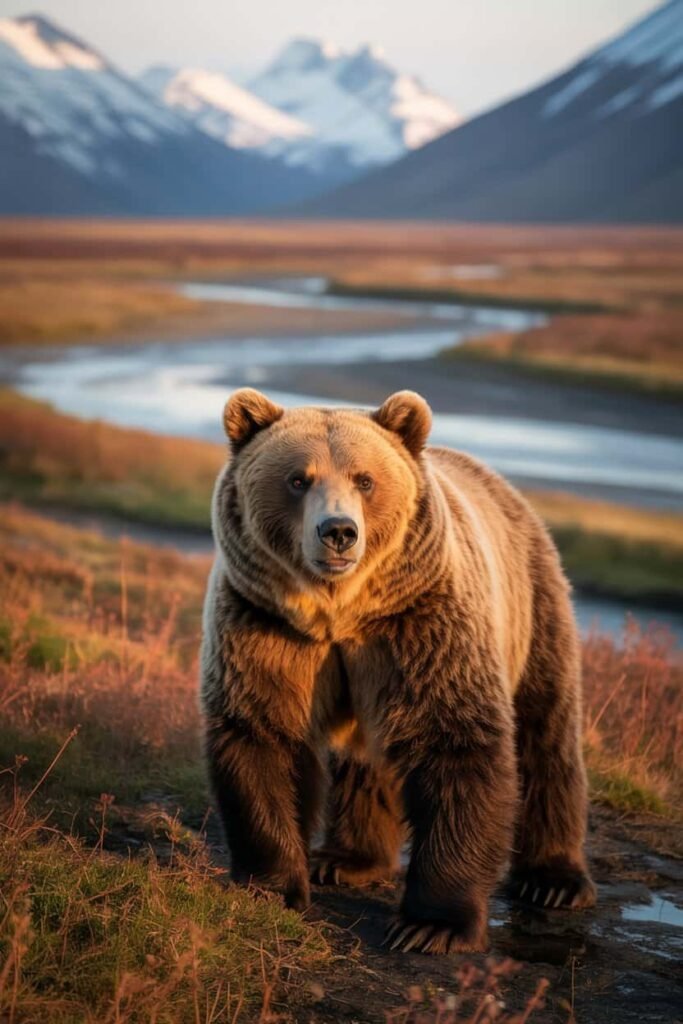
For safe and ethical wildlife viewing, rangers recommend:
- Maintaining at least 300 yards from bears and wolves
- Staying at least 25 yards from all other wildlife
- Using binoculars or telephoto lenses rather than approaching animals
- Never feeding wildlife, which habituates them to humans
- Moving slowly and quietly to avoid startling animals
The Denali Park Road offers excellent wildlife viewing opportunities, particularly in open areas like the Toklat River valley and the Polychrome Pass region. Many visitors find that the transit buses are best for wildlife spotting as they can be flagged down to stop when animals are sighted. [SOURCE]
Along with the Kenai Fjords National Park, Denali offers some of Alaska’s most accessible wildlife viewing opportunities.
Best Ways to See Denali Mountain and Panoramic Viewpoints
Finding the best way to see Denali Mountain can be challenging, as the massive peak creates its own weather systems and is often shrouded in clouds. In fact, only about 30% of visitors get a clear view of the mountain during their stay. However, with some planning and flexibility, you can increase your chances of witnessing this awe-inspiring sight.
There are several methods to experience views of Denali, each offering a unique perspective:
Denali Park Road Tour Viewpoints – Best Way to See Denali Mountain
Several stops along the Denali Park Road offer spectacular mountain views on clear days:
- Stony Hill Overlook (mile 62) – Often considered the best road-accessible viewpoint
- Eielson Visitor Center (mile 66) – Offers information displays about the mountain along with panoramic views
- Wonder Lake (mile 85) – Famous for mirror-like reflection views of Denali in calm conditions
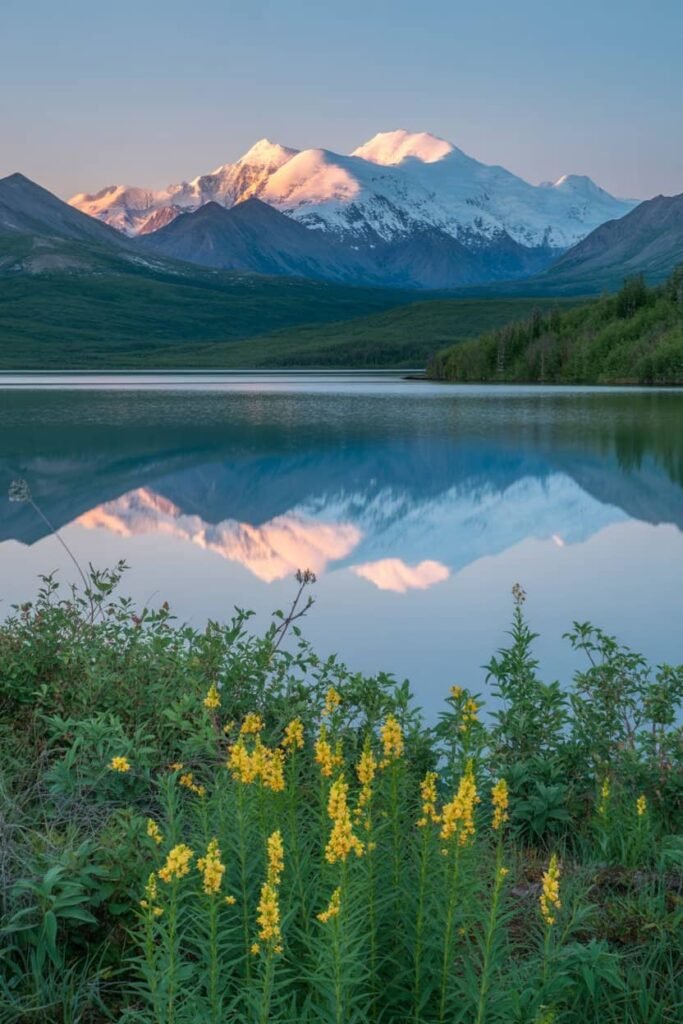
Denali Flightseeing Tours from Talkeetna – Scenic Flights Over Denali Mountain
For many visitors, flightseeing provides the most memorable Denali experience, bringing you close to the mountain’s massive south face, with views of surrounding glaciers and the Alaska Range impossible to see from the ground. Tours operate from Talkeetna and other nearby towns, weather permitting.
Backcountry Hiking in Denali – Trails and Viewpoints to See Denali Mountain
Several hiking trails offer excellent mountain views:
- Mount Healy Overlook Trail – A moderately difficult 2.7-mile trail near the park entrance
- Savage Alpine Trail – A challenging but rewarding 4-mile trail with open views
- McKinley Station Trail – An easier 1.6-mile historical walk with possible mountain views
For the best chances of seeing the mountain clearly:
- Plan your visit for early morning (before 11 AM) when clouds are less likely to obscure the view
- Allow several days in your itinerary to increase your chances of clear weather
- September often offers clearer skies, though with cooler temperatures
- Consider visiting other parts of Alaska if Denali remains hidden during your stay
Many locals say that Denali “makes its own weather,” so patience and flexibility are key to catching that perfect view.
Denali Flightseeing Tours from Talkeetna and Glacier Landing Options
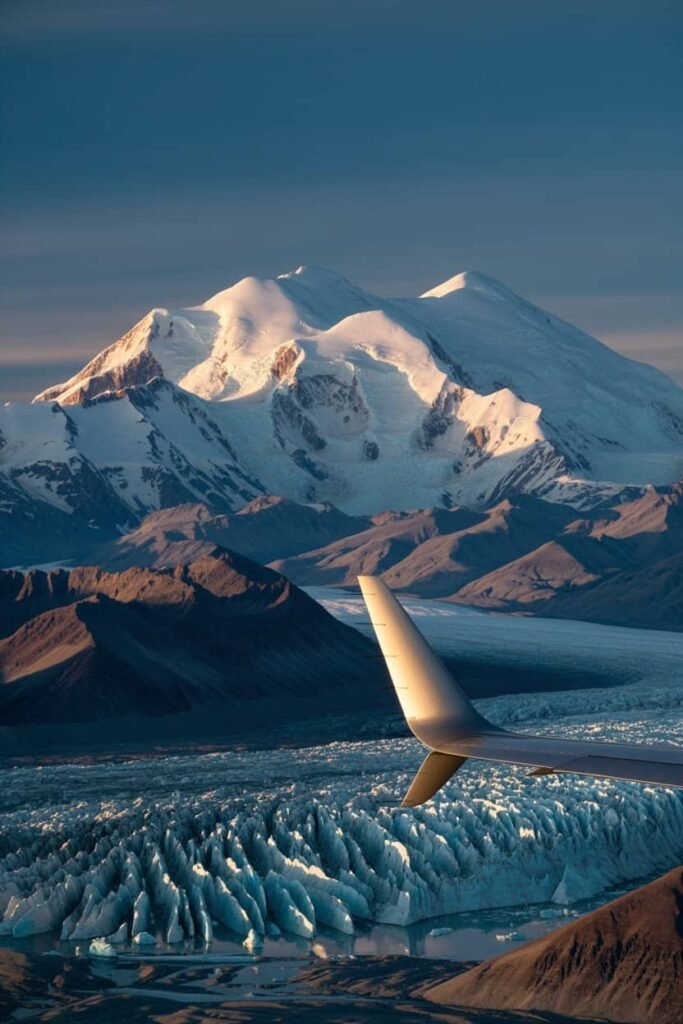
Denali flightseeing tours from Talkeetna offer perhaps the most spectacular way to experience the mountain’s grandeur. The charming town of Talkeetna, located about 150 miles south of the park entrance, serves as the main hub for these aerial adventures, with several flight operators offering a range of tour options.
Flightseeing tours typically last between 1-2 hours and provide views that are simply impossible to experience from the ground. As your small aircraft soars above the Alaska Range, you’ll witness:
- Massive glaciers flowing between peaks, with deep blue crevasses and ice falls
- Dramatic granite walls of Denali rising more than 15,000 feet from base to summit
- Alpine basins and valleys carved by thousands of years of glacial movement
- Remote wilderness that few humans ever see
Many tours offer the thrilling option of a glacier landing, where the pilot touches down on a snowfield, allowing passengers to step out onto the glacier for an unforgettable experience. These landings typically add 30 minutes to the flight time and additional cost.
When booking a flightseeing tour:
- Reserve well in advance during peak summer season (June-August)
- Schedule your flight for morning hours when visibility is typically better
- Build flexibility into your plans, as flights may be canceled or rescheduled due to weather
- Bring a camera with extra batteries – the views are unparalleled
- Wear warm layers even in summer, as glacier landings can be quite cold
Tours range from about $250-$550 per person, depending on duration and whether they include a glacier landing. While this represents a significant expense, most visitors consider it a worthwhile investment for the once-in-a-lifetime perspective it provides.
Talkeetna itself is worth exploring before or after your flight, with its historic downtown, mountain-town atmosphere, and excellent dining options. The trip from Anchorage to Talkeetna is also scenic, making it an excellent day trip option. [SOURCE]
Backcountry Hiking in Denali National Park and Trail Guide
Backcountry hiking in Denali offers an unparalleled wilderness experience for those willing to venture beyond maintained trails. Unlike most national parks, Denali features very few established trails, instead encouraging hikers to forge their own routes through its vast landscapes. This trail-less system creates a true wilderness experience but requires proper preparation and navigation skills.
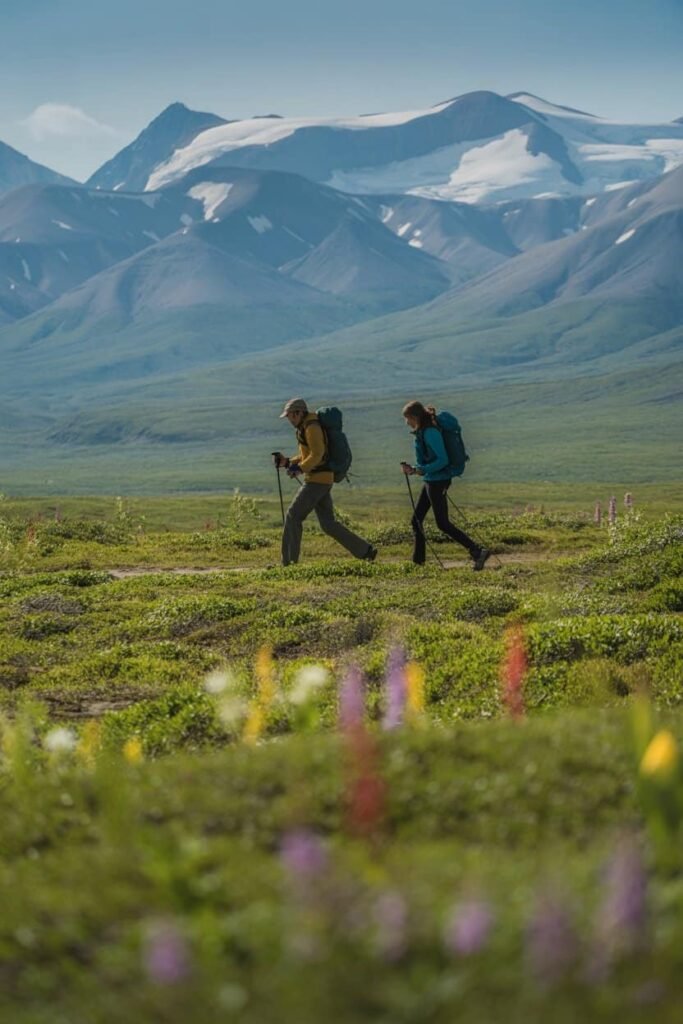
The park is divided into 87 backcountry units, each with daily quotas for overnight camping. For day hiking, permits aren’t required, but for overnight stays, you’ll need to:
- Obtain a backcountry permit at the Backcountry Information Center near the park entrance
- Watch a safety video about wilderness travel and bear encounters
- Discuss your planned route with rangers who can suggest appropriate areas based on your experience level
- Receive a bear-resistant food container for proper food storage
For those new to backcountry travel, several maintained trails near the park entrance provide excellent day hiking options:
- Savage River Loop (2 miles) – An easy trail with river views and possible wildlife sightings
- Mount Healy Overlook (2.7 miles) – A moderately strenuous climb with panoramic views
- Triple Lakes Trail (9.5 miles) – The park’s longest maintained trail, featuring forest and lake scenery
- Savage Alpine Trail (4 miles) – A challenging route with dramatic alpine views
Safety is paramount when hiking in Denali. Essential preparations include:
- Carrying bear spray and knowing how to use it
- Bringing navigation tools (map, compass, and possibly GPS)
- Packing for rapidly changing weather with layered clothing
- Taking extra food and water beyond what you think you’ll need
- Informing someone of your planned route and expected return time
When hiking, make noise to avoid surprising wildlife, especially in areas with limited visibility. Travel in groups when possible, and be prepared for stream crossings, brushy terrain, and potential wildlife encounters. [SOURCE]
Practical Travel and Trip Planning Tips for Denali National Park
Planning a trip to Denali National Park requires attention to several key details to ensure a smooth and enjoyable experience. From timing your visit to securing necessary reservations, these practical considerations will help you make the most of your adventure.
Best Time for Travelling to Denali National Park
The park’s main visitor season runs from mid-May through mid-September, with peak visitation in July and August. Consider these seasonal factors:
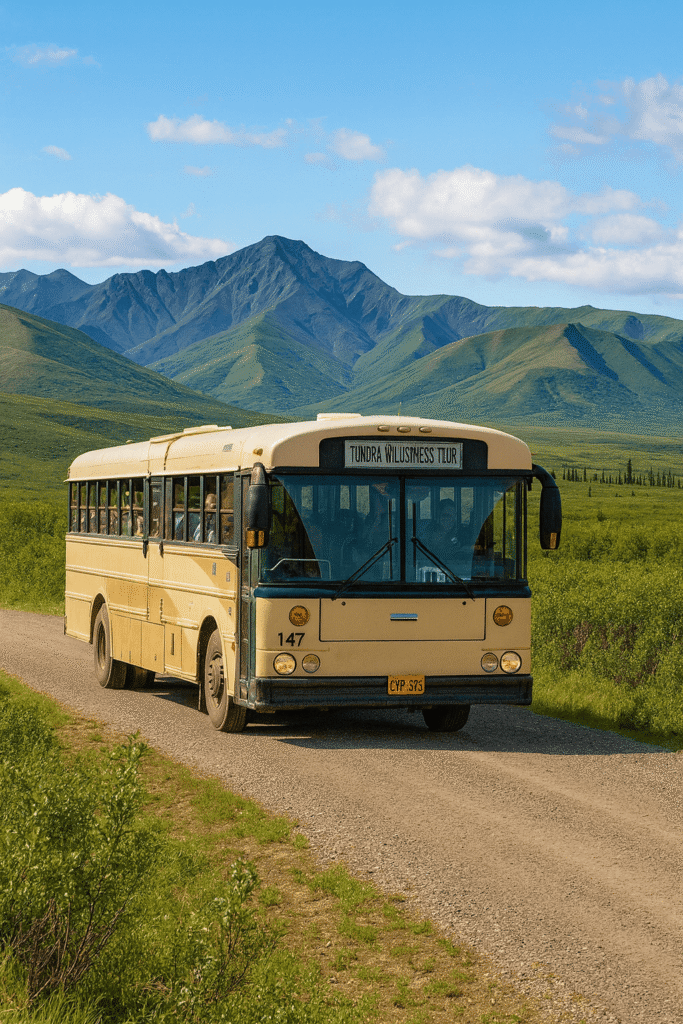
- Mid-May to early June – Fewer crowds, possible snow at higher elevations, and limited wildlife activity
- Late June to mid-August – Optimal weather, full services, peak wildlife activity, and longest daylight hours
- Late August to mid-September – Fall colors, fewer crowds, possible early snow, and better chances of clear mountain views
The park is technically open year-round, but winter visits require significant cold-weather experience and self-sufficiency.
Denali National Park Permits and Reservations for Backcountry Hiking
Several key reservations should be secured well in advance:
- Bus tickets – Transit and tour buses fill up quickly for peak season dates
- Campground reservations – Especially for Riley Creek, Savage River, and Wonder Lake campgrounds
- Backcountry permits – Available in person up to one day before your trip, cannot be reserved in advance
Where to Stay When Traveling to Denali National Park
Staying within or near the park presents several options:
- Park campgrounds – Six campgrounds with varying amenities and accessibility
- Park lodges – Limited lodging is available inside the park at Kantishna
- Gateway accommodations – Hotels, lodges, and cabins in nearby communities like Healy (7 miles north) and Talkeetna (150 miles south)
The cost of accommodations in Alaska varies widely by season, with peak summer rates being significantly higher.
Transportation and Access for Denali Park Road Tour and Flights from Talkeetna
Getting to and around the park requires planning:
- Park access – Most visitors arrive by car from Anchorage (4 hours) or Fairbanks (2 hours)
- Alaska Railroad – Offers scenic daily summer service to the park from Anchorage and Fairbanks
- Shuttle services – Available from major cities and nearby towns
- Park transportation – Free shuttle buses operate in the entrance area, connecting visitor facilities
Essential Packing List for a Trip to Denali National Park
Alaska’s variable weather demands thoughtful packing:
- Layered clothing – Temperatures can range from 40°F to 80°F in a single summer day
- Rain gear – A Waterproof jacket and pants are essential year-round
- Sturdy footwear – Waterproof hiking boots are recommended
- Insect repellent – Alaska’s mosquitoes are notorious in early summer
- Binoculars – Essential for wildlife viewing and distant mountain scenery
- Camera gear – Extra batteries and memory cards for capturing the park’s beauty
- Day pack – For carrying essentials on bus rides and day hikes
For visitors arriving via cruise ships, consider how Denali fits into your broader Alaska cruise itinerary.
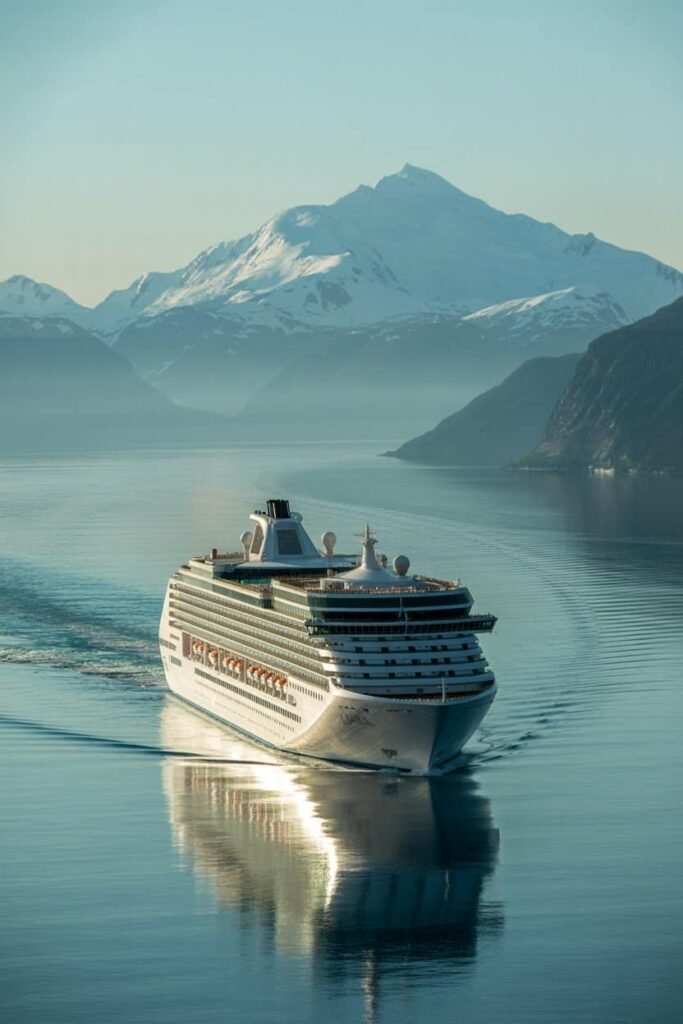
Frequently Asked Questions about Denali National Park
What is the best season to visit Denali National Park for weather, daylight, and wildlife viewing?
The best season to visit Denali National Park is from mid-June through early September, when daylight hours are longest, wildlife is active, and all visitor services along Denali Park Road are open. July and August bring the warmest temperatures, while late August to early September offers colorful tundra scenery and fewer crowds.
How far can visitors drive on Denali Park Road, and how do the shuttle and tour buses operate?
Private vehicles can only travel up to mile 15 (Savage River) on Denali Park Road. Beyond this point, visitors must use the park’s shuttle or narrated tour buses, which make scheduled stops at scenic points such as Polychrome Pass, Toklat River, and Eielson Visitor Center. Transit buses allow flexible hop-on-hop-off access for hiking and photography.
Do visitors need permits or reservations for backcountry hiking and camping in Denali National Park?
Yes, overnight stays in Denali’s backcountry require a permit from the Backcountry Information Center near the entrance, along with a safety briefing. Day hikes on marked trails do not require a permit, but travelers should always inform rangers of their plans. Backcountry areas are divided into 87 zones with limited daily quotas, so advance preparation is essential.
How can travelers improve their chances of seeing Denali Mountain clearly during a visit?
Denali Mountain is often hidden by clouds, and only about 30% of visitors see it clearly. The best chances come early in the morning before 11 AM, or during late summer when skies tend to be clearer. Spending multiple days in the park or joining a flightseeing tour from Talkeetna can significantly improve visibility opportunities.
What wildlife safety and hiking precautions should visitors follow in Denali National Park?
Denali’s wildlife is completely wild—keep at least 300 yards from bears and wolves and 25 yards from other animals. Carry bear spray, hike in groups, make noise on trails, and store food in bear-resistant containers. Always carry navigation tools and extra supplies, as cell coverage is minimal throughout the park’s interior.
Conclusion
Exploring Denali National Park offers a rare opportunity to experience the vastness and raw beauty of Alaska’s wilderness. From the scenic drives along Denali Park Road to the immersive solitude of its backcountry trails, each experience reveals a different side of the region’s natural grandeur.
Flightseeing tours from Talkeetna provide unmatched aerial views of Denali Mountain and its glaciers, while bus journeys into the park showcase dynamic wildlife across open tundra and rugged valleys. Every route, viewpoint, and hike contributes to a deeper appreciation of the park’s untouched landscapes.
Visitors who plan carefully—choosing the right season, securing permits, and allowing flexibility for weather—can witness Denali at its best. The park rewards patience with unforgettable moments of quiet beauty and wildlife encounters that define true wilderness travel.
To extend your Alaska journey, explore nearby destinations like Kenai Fjords National Park or travel the scenic Alaska Railroad for more breathtaking views across the state’s interior and coastal regions.
For more stunning views of Alaska’s natural wonders, visit Pathfinders Travel YouTube channel, where you can watch travel documentaries about Denali and other wonders of the world in beautiful 4K resolution.

